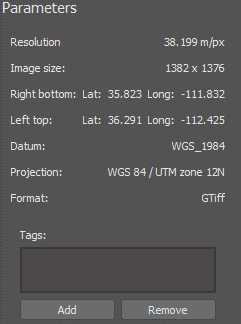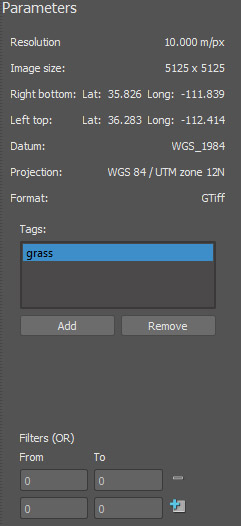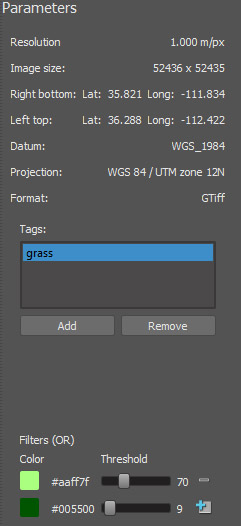Generating Detail Masks
Detail masks are generated on the basis of landcover data available. The basic workflow is as follows:
1. Adding a Landcover Data Source and Specifying Tags
First we should add a new landcover data source to be used for generation. If necessary landcover data source is already added, you may skip to step 3.
-
Open the Landscape Tool window, for this purpose on the Menu bar, click Windows -> Landscape.
-
In the Data Sources panel, add necessary landcover data sources (see Specifying Data Sources section).
NoticeR8 and RGB8 mask textures are supported. -
Select each landcover data source from the ones you added in the Data Sources panel and specify parameters in the Parameters panel.

-
Add tags for each type of detail mask you are going to generate by clicking Add button at the bottom of the Parameters panel and specifying a tag name. To remove a tag use Remove button.
NoticeYou can't add tags named "height" and "mask" as these names are reserved for procedural refinement. -
For each tag you can specify a set of filters (OR) to select certain data from the landcover data source. You can add as many filters as necessary. This can be done as follows depending on the type of the landcover data source:
- For an R8 texture data source - by setting the range of bits (from value, to value) to be treated as a certain detail mask.
- For an RGB8 texture data source - by selecting a base color and setting threshold value for a color gradient to be treated as a certain detail mask.
NoticeUse "+" (plus) button to add a filter, or "-" (minus) to remove one.1-channel R8 texture. 3-channel RGB8 texture. 

-
Now all necessary tags and filters are added and you can proceed to the next step.
2. Adding Detail Masks
Now, we must determine which tags are to be used to generate detail masks.
-
In the Natural Layer panel, select Detail Masks and the list of tags determined for all landcover data sources will be displayed in the Parameters panel.

-
Check the tags you added at the previous step to be used for generation of detail masks.
-
Now all necessary detail masks are specified and bound to tags.
NoticeIf the terrain is already generated and you want to add only detail masks - proceed to Step 3.
Otherwise - return back to setting other parameters of terrain generation.
3. Generating Detail Masks
Now you can generate detail masks by clicking Generate button and selecting Terrain -> Details option in the Generation Steps window, in this case only detail masks will be generated.